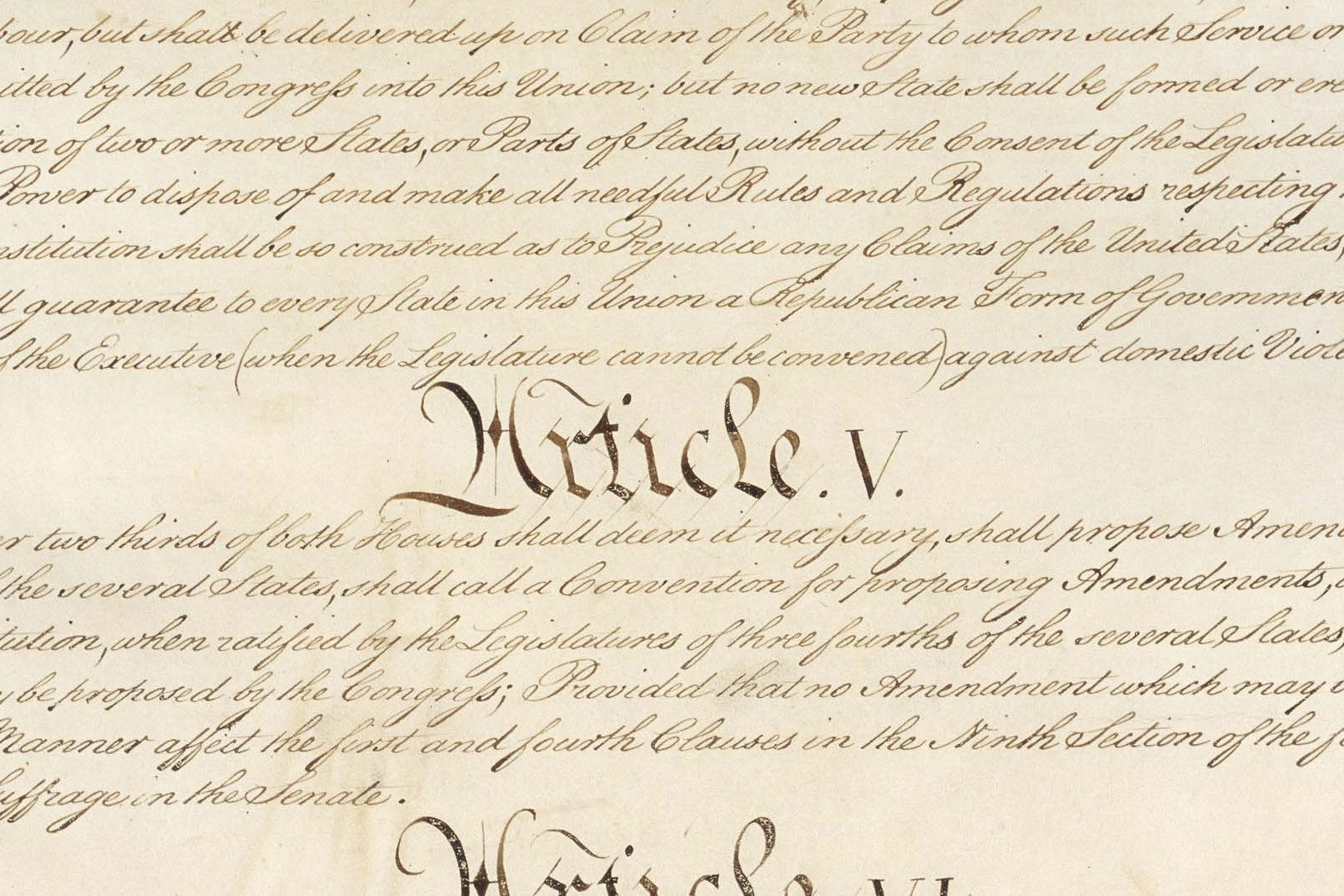Listen 
Article V of the United States Constitution reflects the wise foresight of the Founding Fathers in creating a mechanism for peaceful change in our nation's fundamental laws. Unlike past revolutions, marked by chaos and conflict, the amendment process in the U.S. Constitution offers a systematic and deliberate approach to making necessary changes to the law. Its structured framework encourages civic engagement by enabling citizens to voice concerns, propose adjustments, and actively contribute to the ongoing refinement of the nation's governing principles.
The reason for this intentional approach is to make sure that any changes to our Constitution happen with the agreement of a supermajority, not just a mere majority. In this way it acts like a safety net that prevents the law from being changed through quick or impulsive decisions that might not be in the best interest of the majority. This process shows how much the American Framers believed in working together, talking things out, and making decisions that the vast majority can agree on.
Two Methods for Proposing Amendments
Article V provides two ways for the Constitution to be amended. The first is through a Congressional Proposal. The second method has never occurred but is known as an Article V Convention. Let’s briefly look at each of these methods.
-
Congressional Proposal: The first method for proposing an amendment to the Constitution takes place in the legislative branch, or Congress. An amendment can be proposed if it receives a two-thirds majority vote in both the House of Representatives and the Senate. This requirement for a two-thirds majority in both chambers acts as a safeguard to ensure that proposed amendments have substantial backing from representatives elected by the people. To date, all 27 amendments to the U. S. Constitution have occurred through this method.
-
Article V Convention: A second method for proposing an amendment to the Constitution could occur if two-thirds of the state legislatures requested Congress to convene an amending convention which would consist of delegates from each state. Currently this would require support from 34 out of 50 states for Congress to be required to call an Article V Convention. This process would essentially bypass a Congressional Proposal and allow the state legislatures or state conventions to both propose and ratify an amendment. The convention's sole purpose would be to propose an amendment to the Constitution based on specific guidelines that would be agreed to beforehand. While this second method has never been used, it reflects the Founders' wisdom in allowing the States to act independently of Congress in proposing amendments. Since they created the national government, they have a right to alter it.
An Article V Convention is a powerful check against federal overreach. It provides an alternative route for proposing amendments when Congress may be unwilling or unable to address issues that are of great concern to the states and the people.
Ratification Process
Proposing an amendment is the initial step which involves drafting the language and presenting it for consideration. Ratification, on the other hand, is the subsequent step where the proposed amendment is officially accepted and incorporated into the Constitution. This step occurs the same way regardless of the method used to propose the amendment.
According to Article V, the ratification process is permitted through two methods. An amendment can be ratified by the state legislatures, or by state conventions. Let’s look at each method.
-
State Legislatures: Amendments can be ratified by the elected legislatures of the individual states.
-
State Conventions: Alternatively, states may call special conventions specifically for the purpose of considering and ratifying proposed amendments.
The method for ratification is determined by the United States Congress. In both cases, the amendment must be ratified by three-fourths of the state legislatures or state conventions.
Three-Fourths Majority Requirement
Requiring the approval of three-fourths of the states is a high threshold deliberately set to ensure that amendments have widespread support. This supermajority requirement acts as a safeguard against the tyranny of a mere majority and is designed to ensure that amendments have substantial backing from a diverse array of states. It also prevents amendments from being ratified based on regional or partisan interests, promoting a national perspective on changes to the Constitution.
Possible Reasons Why an Article V Convention Has Never Happened
Many people have wondered why this second method of amending the Constitution has never been used. While there are varying opinions, here are a few things to consider.
-
Familiarity and Tradition: The first method, involving Congress, has become the traditional method used from the Bill of Rights (amendments 1 – 10) to the twenty-seventh amendment, ratified May 7, 1992. Since we are creatures of habit, change does not come easily, and It’s easy to say, “that’s just the way we do things.”
-
Efficiency: Proposing amendments through Congress is often seen as a more efficient and coordinated process. It allows for a centralized and structured approach to constitutional changes. Organizing a Convention of the States could be viewed as an additional and unfamiliar step to propose an amendment.
-
Congressional Authority: Article V grants a key power to Congress for the purpose of amending the Constitution. Since Congress represents the people in the House of Representatives, and originally represented the States in the Senate, it was designed to be a natural and effective body for proposing amendments.
-
Congressional Action to Avoid a Convention: In a few cases Congress was faced with pressure from the states to pass an amendment. Rather than allowing the States to obtain a two-thirds majority and propose an amendment, Congress chose to capitulate rather than allow a convention of the states to convene. Here are two examples:
-
Seventeenth Amendment (1913): By the early 20th century, a significant number of states had expressed support for changing the election process for Senators. Faced with the possibility of a convention of states, Congress passed the Seventeenth Amendment in 1913, providing for the direct election of Senators by the people.
-
Twenty-First Amendment (1933): A movement to repeal Prohibition gained traction with a considerable number of states that expressed support for ending the ban on intoxicating liquors. Responding to the widespread sentiment, Congress proposed the Twenty-First Amendment in 1933, repealing the Eighteenth Amendment and ending Prohibition.
Fear of a "Runaway Convention"
One concern associated with a convention of states is the fear of a "runaway convention." This term implies a scenario in which a convention, once convened, goes beyond its intended scope and drafts a radical new constitution rather than addressing the specific issue(s) for which it was called. While there are risks in entering uncharted waters, here are a few things to consider with a convention under Article V.
- While the states have the authority to call a convention for the purpose of proposing an amendment, each state must understand the specific nature and scope of the convention before acknowledging their intent to attend – if a two-thirds majority is reached. Specifying the subject matter places an important check on the convention's powers by only authorizing the delegates to convene for a stated purpose. The obvious counter to this is: “it happened before, so why couldn’t it happen again”. This leads to the second point.
- Sometimes a convention of states is referred to as a Constitutional Convention. While it is similar in structure to the 1787 Constitutional Convention, a Convention of the States can only be formed to propose amendments to the Constitution and isn’t a constitutional convention in its true form. A constitutional convention typically implies a gathering to draft an entirely new constitution. This is not what Article V allows.
- If the convention were to propose changes outside of the designated issue(s), the recommended amendments would still need to gain approval by three-fourths of the state legislatures or state conventions. This requirement ensures that any proposed alterations to the Constitution would have to reflect a broad and substantial national consensus, not just a mere majority as with a presidential election.
- In addition, the Supreme Court could act as an additional check on this process – a check the Articles of Confederation did not possess. If the convention were to exceed its mandate or propose changes unrelated to the specified amendment, the Supreme Court could intervene, declaring such actions as contrary to the constitutional framework.
Consider this additional thought. The framers were essentially in the midst of an “Article V” convention gone awry, and yet they still included this amendment method in the Constitution.
Conclusion
Article V of the United States Constitution stands as a testament that the Founding Fathers were committed to creating a government that the people could peacefully and deliberately maintain and repair. Through this amendment process they established a safeguard against impulsive alterations, by requiring the amendment process to be a thoughtful dialogue, resulting in a super-majority consensus.
They wisely included a way for the states to independently amend the Constitution in the event that Congress failed to meet the needs of the states or the people. Perhaps they included this second method for a time such as this, inspired by the second paragraph in the
Declaration of Independence.


18 comments
Barry Keene
Your insistence that the Supreme Court could block a runaway Article V Convention is ridiculous! That Convention could simply abolish the Supreme Court, exactly like the way the citizens attending the Philadelphia Convention of 1787 ignored the clearly limited authority provided by Congress under the Articles of Confederation. If international treaties (each state was a nation), a uniformly acknowledged compact, and the explicit instructions of Congress and the states that sent them, could not stop them, nothing could, even had there been, some supreme court at the time.
Jenny
The Article V convention is so regulated that the runaway convention myth cannot happen. Also, with two-thirds of the states needing to call the convention and three-fourths of the states needing to ratify the proposed amendments, it is a high bar to attain to actually get those amendments passed. With one vote to one state, even the highly populated states have no advantage over the smaller states. It is time for the runaway federal government to be forced to relinquish the power and give it back to the states. We the people.
Cindy Nation
TO Matthew Clendenen Amendments do three things- 1) clarify something already in the Constitution, 2) overturn a Supreme Court ruling, or 3) add a new rule not already in the Constitution. While the federal government follow the Constitution, it is not the same one with only 4500 words in it that we do. They followed the “annotated” Constitution that also contains some 6000 rulings of the court making in about 3000 pages of words. That twisting and interpreting for themselves is how they seem not to follow the Constitution. But over history the have obeyed every amendment (especially those that have clarified) for at least 100 years exactly as they were adopted. Women still vote, slavery does not exist, presidents still leave office after 2 elected terms. Because they are written in unequivocal language they leave no room for interpretation for at least that 100 years and many for longer than that. We have the “Lamp of Experience” that previous amendments were obeyed to show that amendments do work. https://articlevinfocenter.com/the-lamp-of-experience-constitutional-amendments-work/
Mike Kapic
Matthew Clendenen
Someone please explain to me how amending a contract that is not being followed is suddenly going to correct the failure to follow the terms of the same contract?